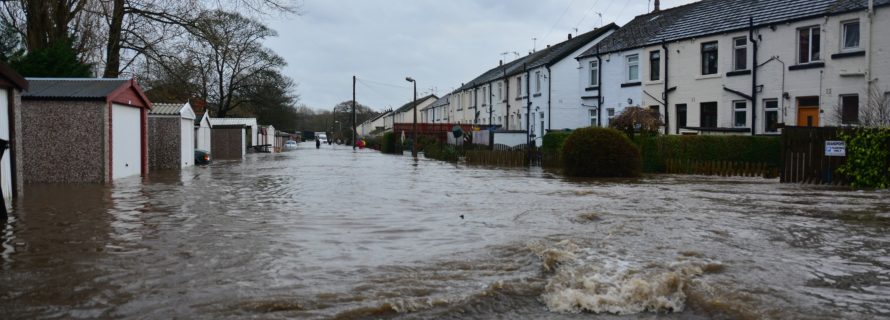Protecting Your Home and its Valuable Contents During a Natural Disaster

Your home is likely your largest investment. It protects you and your family from the elements. It and its contents represent who you are, and include your personal treasures and heirlooms. So in the event of a natural disaster, which are occurring with greater intensity than ever before, according to Resources for the Future, it makes sense to be proactive about protecting the things you love.
Here is some advice and tips on natural disaster preparedness for homeowners. Hopefully, you never need to go through one – but as recent events have shown, it’s always a good idea to be ready.
We’ll take a look at three common disaster scenarios and some actions you can take in advance to protect your home and its contents from damage or loss:
- Hurricanes and high winds
- Rain and flooding
- Earthquake
High Winds/Hurricane
Garage Doors – One of the most effective steps you can take is to replace garage doors with ones that can withstand winds up to 130 mph. This is because typically, weaker ones will blow off, allowing winds to enter your home. The resultant interior pressure can actually get so high that it blows the roof off, from the inside.
Seal Around Windows & Doors – High wind, coupled with rain, can easily make its way through gaps in windows and doors, creating interior water damage. Make sure the exterior of your home is properly caulked and sealed to prevent this.
Porch & Carport – In times of extreme wind, these two features on your home exterior are very susceptible to wind damage. You can reinforce both by ensuring the support beams which hold them up are tightly secured to the ground
Rain and Flooding
Backflow Valves – During times of high rain, sewage lines can overflow and actually go backward, into your house, causing severe damage to basement contents. Make sure that the pipes leaving your house have backflow valves installed. They prevent sewage water backup.
Storm Drains – These are intended to take on excess amounts of water from heavy rains. They’re not effective, however, if they become clogged with debris —the accumulating water’s flow will be impeded, and flooding could result. You don’t want this to happen. Ensure that storm drains are cleared and free of debris.
Keep Appliances Above Flood Level – Washer, dryer, heater, furnace; all such appliances should be kept a foot minimum above your property’s flood level. Not doing so risks them being ruined by heavy rains and subsequent flooding.
Sandbags – in the event of a hurricane or torrential rain, sandbags can be your best friend. Prior to an impending major storm event, stack them at all your doorways, at least a foot high, and extending beyond the edges of the door. Particularly if you live in a flood-prone location, you should always have sandbags on-site, or somewhere nearby, so you can be prepared for the worst.
Earthquake
Chimney – Even if the rest of your home withstands an earthquake, your chimney might not. The movement of the earth could displace and topple it. One way to secure it is to install a diagonal steel brace to the exterior of the chimney, to help hold it in place during such an event.
Cripple Wall – This short wall connects the first floor of your home to the crawl space below. Often, they are not strong enough to withstand the tremors of an earthquake, if the cripple wall collapses, the rest of your house can be severely damaged. Reinforce your cripple walls by adding nailed wood boards between the studs.
Secure House to Foundation – In an earthquake zone, one of the wisest things you can do is make sure your house is bolted to the foundation. This should be done by a professional, using anchor bolts in the correct locations. Unsecured, an earthquake may separate your house from its foundation, resulting in potentially catastrophic structural damage to it and its contents and causing costly repairs.
Last Thing – All Natural Disasters
Maybe you’ve been lucky so far. Maybe you think it won’t happen to you. Don’t gamble with Mother Nature —obtain homeowner’s insurance and have a close look at what it covers. If you’re in an area prone to damage from natural disasters, it’s the wise thing to do.
About The Author: Kerry is a Consumer Advocate at Ownerly, a leading home valuation company and consumer resource whose mission is to put professional home value data and insight in your hands.
Photo by Chris Gallagher on Unsplash
- Additions and New Construction
- All Exteriors
- Alterations
- Basements
- Bathrooms
- Customer Service
- Customer Stories
- Decks
- Design & Planning Show
- DIY
- Doors
- Educational Resources
- Extreme Makeover Home Edition
- Fashion Show
- General Remodeling
- Green Living
- Handyman Home Services
- Home Decor
- Home Entertainment
- Home Improvement
- Home Improvements
- How to Tips
- In The Community
- Kitchens
- Off-the-Wall Remodeling Stories
- Remodeling
- Resources
- Roofing
- Siding
- Social Media
- Sunrooms
- Tips & Tricks
- Trends
- Windows

